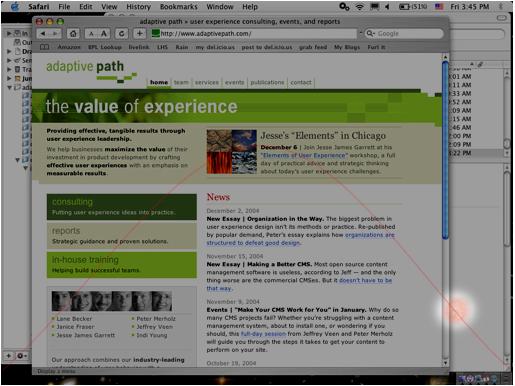I love my TiVo. And, as a user experience professional, I love what TiVo has done to offer a thoughtful, simple, straightforward, and streamlined interface. As such, I was looking forward to Matt’s interview with TiVo’s head of User Experience, Margret Schmidt.
And as such, I was disappointed by the pabulum spewed, the lack of informative detail, and the bizarre marketroid speak.
TiVo was offered a real opportunity to connect with the larger user experience community, and did little to take advantage of that.
There are two good things in the interview: Margret’s discussion of the TiVo design mantra’s, and the skip-to-tick incident.
There are two utterly mundane things in the interview: a warmed-over, uninsightful discussion of process, and the discussion of Requests for Enhancement.
There is one particularly frustrating thing in the interview: The phrase “Innovation is a by product of a talented team,” which is the not backed up in anyway. How do you put together a talented team? What is the makeup of your team?
There is one bizarre bit of marketroid speak that must have been the writing of a PR Flak, which I’ll just reprint fully:
It is actually pretty easy to balance the needs of the two groups, because in general they have the same goals. Users want to watch quality programming when, where, and how they want to. Studios want their programming enjoyed by the masses. TiVo simply empowers users to control their TV consumption within the guidelines of fair use. We have strong security system called TiVo Guard(TM) that protects the interests of the studios. We don’t support the inappropriate distribution of copyrighted content, and our users aren’t asking for it.
Normal people don’t say “quality programming.” And the rest is a pathetic sop to the content industry. Shame!
There is one lie: “In general a feature won’t be ruled out as “too complex” because we have strong design team that can make anything easy to use.” The world’s strongest design team can’t make “anything” easy to use. There are moments of necessary complexity.
It’s unfortunate that TiVo wasn’t willing to truly engage with the design community on their work. It’s unclear if Ms. Schmidt simply cannot articulate what has actually lead to TiVo’s design success, or whether she was muzzled/blanded by an overzealous PR team. Either way, TiVo ends up looking worse in the eyes of the discriminating design community.
I hope they make up for it in their upcoming presentation to BayCHI, where perhaps, in such a forum, truth and honesty can bear out.
